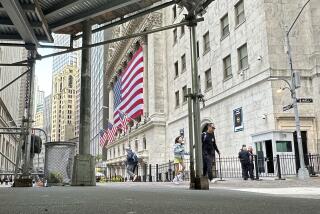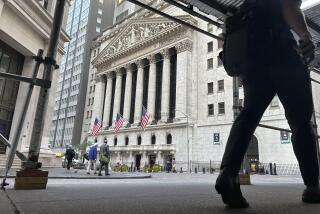Will Tech Continue Leading Rebound?
The stock market is on a hot streak, and technology issues are leading the charge.
Of course, investors have heard that come-on before, and for the last 2 1/2 years it has been to their peril to believe that any rebound -- especially in tech -- would be more than transitory.
That’s why suspicions are running high with Wall Street again in recovery mode, even though some market bulls say their reasons for optimism are as solid as they’ve been in a long time.
The Dow Jones industrial average closed out Friday up for the seventh straight week, the longest winning streak since 1998. The technology-dominated Nasdaq composite index ended at 1,468.74 on Friday, its highest close since June 19.
Since reaching five-year lows in early October, the Dow is up 20.8%, at 8,804.84, and the Nasdaq index is up 31.8%.
The last rally of this magnitude occurred in the fourth quarter of 2001, as the market rebounded from the sell-off that followed the Sept. 11 terrorist attacks.
Then, as now, battered tech stocks led the way. In fact, the advance among the tech sector’s biggest names is on an eerily similar pace: The Nasdaq 100 index, which comprises the most prominent Nasdaq tech firms, has risen 38.7% from its October low. A year ago at this time the index was up 40% from its post-attacks low.
Last year’s fourth-quarter rally lasted until the first week of January. The market then struggled through the winter before plunging anew in spring and summer amid a wave of corporate financial scandals.
Someone who one year ago today bought the so-called QQQ fund, which replicates the Nasdaq 100 index, still is down 31% despite the rally of recent weeks.
No wonder many investors are suspicious.
“There appears to be a fairly common assumption among market followers that the rebound in prices since the lows of October is merely a ‘bear market rally,’ ” said Richard McCabe, chief market analyst at Merrill Lynch & Co. in New York.
Small investors seem particularly wary. Despite the heady gains of the major market indexes since early October, stock mutual funds have taken in relatively little in new cash in the last four weeks, according to AMG Data Services, which tracks fund cash flows.
Indeed, in the week ended Wednesday investors pulled a net $2 billion out of stock funds, AMG estimated.
A high level of skepticism can be a good thing for Wall Street: It often means there still is plenty of money on the sidelines, waiting to be lured into a continuing rally.
Among professional investors, however, bullish sentiment has rebounded sharply since early October. Last week’s poll of independent market newsletter writers by Investors Intelligence showed 49.4% are bullish, up from fewer than 30% at the market’s bottom in October. The remainder either are bearish or expect at least a short-term pullback in stocks.
Yet even the professionals are holding back a bit: The bulls had topped 60% in the newsletter poll in early 2001 and reached 55% in spring of this year, in both cases preceding fresh market plunges.
Other trends also point to a relaxation of the fear level in the market. Yields on corporate “junk” bonds have tumbled as some investors have rushed back into those securities. The yield on an index of 100 junk issues tracked by KDP Investment Advisors fell to 10.53% on Friday, the lowest since early June and down from a peak of 12.34% in mid-October. (As the yield of a bond falls, its price rises.)
Investors’ renewed interest in junk bonds suggests growing faith that the economy will continue to improve in 2003, and thus that there is less risk of debt-heavy companies’ being unable to pay their bills.
“We find very compelling fundamentals now” in the junk market, said Jack Ablin, chief investment officer at Harris Trust in Chicago.
But junk bonds also are a favorite playground of market timers -- investors who are looking for no more than a short-term trade (or, in other words, a bear market rally). Credit-rating firm Moody’s Investors Service, in a report Friday, said that despite the recent slide in junk bond yields, “investors are still in a state of high anxiety regarding their attitude towards credit risk.”
For stocks and junk bonds, a central question is whether the economy will be OK in 2003.
On that front, some reports last week indicated that the outlook is improving. The Conference Board said its index of leading economic indicators stabilized in October, halting a four-month slide. And the government said weekly claims for jobless benefits hit a four-month low.
Big investors who have been putting cash to work in stocks say that even if the economic outlook remains murky, the market’s mood has rightly improved since early October. “The market was priced for Armageddon, and that’s just not the scenario,” Ablin said.
As was the case a year ago, the current rally also has the calendar on its side.
The November-to-January stretch historically has been the stock market’s strongest period of the year. Knowing the seasonal trends, many money managers may prefer to get on board a market advance rather than fight it, even if their conviction isn’t strong.
The key differences between now and a year ago or two years ago, Wall Street’s bulls say, is that share prices are substantially lower, and so are most interest rates. In addition, with Republicans now in control of Congress, investors are expecting new tax cuts for businesses and consumers in 2003.
Those factors should keep this rally from abruptly reversing, optimists say.
What’s more, many Wall Street pros say, financial and accounting scandals have become old stories, and investors are figuring that the worst of the bad news on that front has passed.
What hasn’t changed since a year ago is the threat of more terrorist attacks or a wider conflict in the Middle East, either of which could dash consumer and investor confidence.
Even for investors who believe that the long bear market is finally over, a big question is whether the devastated technology sector would lead a rebound. Typically, when new bull markets begin, the leaders aren’t the same stocks or sectors that led the last bull market. Investors move on to other ideas.
So why are tech shares out front again?
In part, the stocks’ gains are a natural snap-back from the deeply depressed levels of early October, analysts say. Institutional investors also know they can use many tech stocks to get back into the market in a hurry, thanks to the sheer number of shares outstanding from firms such as Cisco Systems Inc. and Oracle Corp.
“Tech offers money managers a way to make up performance very quickly” when the market is turning, said Kevin Marder, market strategist at Ladenburg Thalmann Asset Management in Los Angeles.
With the average domestic stock mutual fund still down 18.1% year to date, according to Morningstar Inc., money managers have a lot of red ink to try to wipe away.
For the tech rally to be sustained, however, investors will have to believe that the fundamentals of the companies will improve substantially in 2003, and that the stocks aren’t already overpriced based on earnings expectations.
Doug Foreman, chief investment officer for domestic equities at Trust Co. of the West in Los Angeles, warns that “there are going to be many tech companies that aren’t going to make it.” That was the market’s message when it pushed hundreds of tech shares to penny-stock levels over the last year, and the message still is valid, he said.
But the industry consolidation that will continue to be forced by tech stocks’ collapse will mean a rosier long-term outlook for the companies that survive, Foreman added. That expectation is helping to fuel the latest rally in the sector.
Already, “companies like EBay, Amazon.com, Yahoo and Expedia completely dominate” their sectors, Foreman said, “and those are still the fastest-growing businesses going.”
*
(BEGIN TEXT OF INFOBOX)
Tech leads the way
Tech leads the way
Technology-heavy Nasdaq indexes have led the stock market’s rebound from the five-year lows reached in early October. How key indexes have risen from their lows:
Nasdaq 100 -- +38.7%
Nasdaq composite -- +31.8%
Dow industrials -- +20.8%
S&P; 500 -- +19.8%
S&P; mid-cap 400 -- +19.3%
S&P; small-cap 600 -- +18.8%
NYSE composite -- +16.8%
*
Source: Bloomberg News
More to Read
Inside the business of entertainment
The Wide Shot brings you news, analysis and insights on everything from streaming wars to production — and what it all means for the future.
You may occasionally receive promotional content from the Los Angeles Times.










